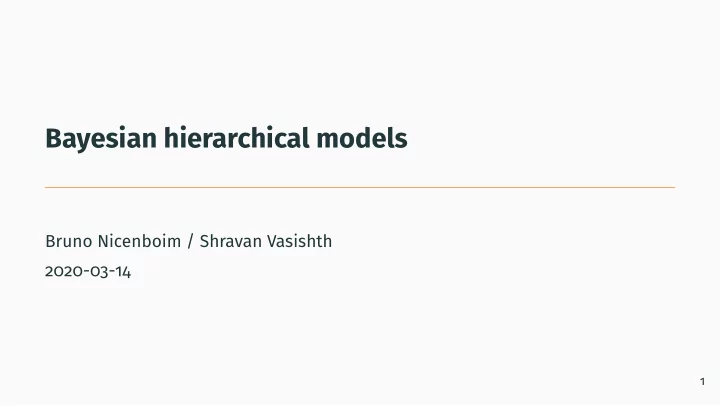

Bayesian hierarchical models Bruno Nicenboim / Shravan Vasishth 2020-03-14 1
Bayesian hierarchical models (also known as multilevel or mixed-effects models) 2
Bayesian hierarchical models (also known as multilevel or mixed-effects models)
The N400 effect (hierarchical normal likelihood) In the EEG literature, it has been shown that words with low-predictability are accompanied by an N400 effect in comparison with high-predictable words, this is a relative negativity that peaks around 300-500 after word onset over central parietal scalp sites (first noticed in Kutas and Hillyard 1980, for semantic anomalies and in 1984 for low predictable word; for a review: Kutas and Federmeier 2011). 1. Example from DeLong, Urbach, and Kutas (2005) a. The day was breezy so the boy went outside to fly a kite. b. The day was breezy so the boy went outside to fly an airplane. 3
4 Figure 1: Typical ERP for the grand average across the N400 spatial window (central parietal electrodes: Cz, downwards). y-axis indicates voltage in microvolts (note that unlike many EEG/ERP plots, the negative polarity is plotted experiment reported in Nicenboim, Vasishth, and Rösler 2020). The x-axis indicates time in seconds and the CP1, CP2, P3, Pz, P4, POz) for high and low predictability nouns (specifically from the constraining context of the 3 2 Amplitude ( μ V) Predictability high low 1 0 0.0 0.2 0.4 0.6 0.8 Time (s)
• We simplify the high-dimensional EEG data by focusing on the average amplitude of the EEG signal at the typical spatio-temporal window of the N400. • We focus on the N400 effect for nouns from a subset of the data from Nieuwland et al. (2018). (To speed-up computation, we’ll restrict the dataset to the participants from the Edinburgh lab) 5
df_eeg_data <- read_tsv ("data/public_noun_data.txt") %>% ## 0.53 0.43 0.00 0.03 -0.44 -0.47 Max. filter (lab == "edin") %>% Mean 3rd Qu. Median Min. 1st Qu. ## df_eeg_data $ c_cloze %>% summary () mutate (c_cloze = cloze / 100 - mean (cloze / 100)) 6
One nice aspect of this dataset is that the dependent variable is roughly normally distributed: Figure 2: Histogram of the N400 averages for every trial in gray; density plot of a normal distribution in red. 7 0.03 density 0.02 0.01 0.00 −75 −50 −25 0 25 50 Average voltage in microvolts for the N400 spatiotemporal window
A complete pooling model We’ll start from the simplest model which is basically a linear regression. Note that this model is incorrect for these data due to point 2 below. 1. EEG averages for the N400 spatiotemporal window are normally distributed. 2. Observations are independent . 3. There is a linear relationship between cloze and the EEG average for the trial. 8 • Model 𝑁 𝑑𝑞 assumptions:
• Likelihood: (1) • Priors: 𝛽 ∼ 𝑂𝑝𝑠𝑛𝑏𝑚(0, 10) 𝛾 ∼ 𝑂𝑝𝑠𝑛𝑏𝑚(0, 10) 𝜏 ∼ 𝑂𝑝𝑠𝑛𝑏𝑚 + (0, 50) (2) 9 𝑡𝑗𝑜𝑏𝑚 𝑜 ∼ 𝑂𝑝𝑠𝑛𝑏𝑚(𝛽 + 𝑑 _ 𝑑𝑚𝑝𝑨𝑓 𝑜 ⋅ 𝛾, 𝜏)
Fitting the model fit_N400_cp <- brm (n400 ~ c_cloze, prior = c ( prior ( normal (0, 10), class = Intercept), prior ( normal (0, 10), class = b), prior ( normal (0, 50), class = sigma)), data = df_eeg_data ) 10
fit_N400_cp 0.16 3214 ## c_cloze 4038 3036 ## ## Family Specific Parameters: ## Estimate Est.Error l-95% CI u-95% CI Rhat ## sigma 11.84 11.54 ## Intercept 12.15 1.00 ## Bulk_ESS Tail_ESS ## sigma 4865 3060 ## ## Samples were drawn using sampling(NUTS). For each parameter, Bulk_ESS ## and Tail_ESS are effective sample size measures, and Rhat is the potential ## scale reduction factor on split chains (at convergence, Rhat = 1). 4301 Bulk_ESS Tail_ESS ## ## Population-Level Effects: Family: gaussian ## Links: mu = identity; sigma = identity ## Formula: n400 ~ c_cloze ## Data: df_eeg_data (Number of observations: 2827) ## Samples: 4 chains, each with iter = 2000; warmup = 1000; thin = 1; ## total post-warmup samples = 4000 ## ## ## Estimate Est.Error l-95% CI u-95% CI Rhat ## Intercept 3.66 0.23 3.22 4.10 1.00 ## c_cloze 2.26 0.55 1.19 3.33 1.00 11
plot (fit_N400_cp) 12 b_Intercept b_Intercept 4.5 1.6 1.2 4.0 0.8 3.5 0.4 3.0 0.0 3.2 3.6 4.0 4.4 0 200 400 600 800 1000 b_c_cloze b_c_cloze 4 0.6 Chain 1 3 0.4 2 2 3 0.2 4 1 0.0 1 2 3 4 0 200 400 600 800 1000 sigma sigma 12 2.5 2.0 12 1.5 1.0 12 0.5 11 0.0 11 12 12 12 12 12 0 200 400 600 800 1000
No pooling model 1. EEG averages for the N400 spatio-temporal window are normally distributed. 2. Observations depend completely on the participant. (Participants have nothing in common.) 3. There is a linear relationship between cloze and the EEG average for the trial. 13 • Model 𝑁 𝑜𝑞 assumptions:
• Likelihood: (3) • Priors: 𝜏 ∼ 𝑂𝑝𝑠𝑛𝑏𝑚 + (0, 50) (4) 14 𝑡𝑗𝑜𝑏𝑚 𝑜 ∼ 𝑂𝑝𝑠𝑛𝑏𝑚(𝛽 𝑗[𝑜] + 𝑑 _ 𝑑𝑚𝑝𝑨𝑓 𝑜 ⋅ 𝛾 𝑗[𝑜] , 𝜏) 𝛽 𝑗 ∼ 𝑂𝑝𝑠𝑛𝑏𝑚(0, 10) 𝛾 𝑗 ∼ 𝑂𝑝𝑠𝑛𝑏𝑚(0, 10)
We fit it in brms by removing the common intercept with 0 + and thus having an intercept and effect for each level of subject : fit_N400_np <- brm (n400 ~ 0 + factor (subject) + c_cloze :factor (subject), prior = c ( prior ( normal (0, 10), class = b), prior ( normal (0, 50), class = sigma)), data = df_eeg_data) 15
Recommend
More recommend